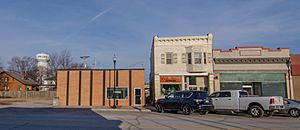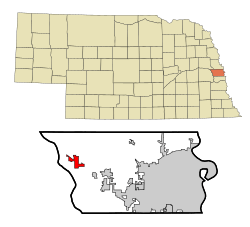Valley, Nebraska facts for kids
Quick facts for kids
Valley, Nebraska
|
||
|---|---|---|

Downtown Valley, March 2017
|
||
|
||

Location of Valley, Nebraska
|
||
| Country | United States | |
| State | Nebraska | |
| County | Douglas | |
| Area | ||
| • Total | 6.06 sq mi (15.69 km2) | |
| • Land | 4.86 sq mi (12.58 km2) | |
| • Water | 1.20 sq mi (3.11 km2) | |
| Elevation | 1,139 ft (347 m) | |
| Population
(2020)
|
||
| • Total | 3,037 | |
| • Density | 625.15/sq mi (241.39/km2) | |
| Time zone | UTC-6 (Central (CST)) | |
| • Summer (DST) | UTC-5 (CDT) | |
| ZIP code |
68064
|
|
| Area code(s) | 402 | |
| FIPS code | 31-50020 | |
| GNIS feature ID | 2397110 | |
| Website | http://www.valleyne.org/ | |
Valley is a city in Douglas County, Nebraska, United States. In 2020, about 3,037 people lived there.
Valley is also home to a special office. This office is part of the National Weather Service. It helps forecast weather for parts of eastern Nebraska and southwestern Iowa.
Contents
History of Valley
Valley became a town in 1864. This happened when it was clear that the Union Pacific Railroad would build tracks through the area. The town got its name from the Platte River valley nearby.
Geography of Valley
Valley is located in Nebraska. Its exact spot is 41°18′51″N 96°20′54″W / 41.31417°N 96.34833°W.
The city covers a total area of about 3.62 square miles (9.38 square kilometers). Most of this area is land. Only a small part, about 0.06 square miles (0.16 square kilometers), is water.
Valley's Climate
Valley experiences a varied climate. Summers are usually warm. Winters can be quite cold. The city gets a good amount of rain throughout the year. It also sees snow in the colder months.
| Climate data for Valley NWS, Nebraska (1991–2020 normals, extremes 1994–present) | |||||||||||||
|---|---|---|---|---|---|---|---|---|---|---|---|---|---|
| Month | Jan | Feb | Mar | Apr | May | Jun | Jul | Aug | Sep | Oct | Nov | Dec | Year |
| Record high °F (°C) | 69 (21) |
78 (26) |
88 (31) |
93 (34) |
100 (38) |
102 (39) |
105 (41) |
102 (39) |
103 (39) |
93 (34) |
84 (29) |
73 (23) |
105 (41) |
| Mean maximum °F (°C) | 55.2 (12.9) |
60.9 (16.1) |
74.3 (23.5) |
84.4 (29.1) |
90.0 (32.2) |
94.2 (34.6) |
96.5 (35.8) |
95.1 (35.1) |
91.9 (33.3) |
84.8 (29.3) |
72.4 (22.4) |
58.1 (14.5) |
97.9 (36.6) |
| Mean daily maximum °F (°C) | 32.9 (0.5) |
37.5 (3.1) |
50.4 (10.2) |
62.4 (16.9) |
72.9 (22.7) |
82.9 (28.3) |
86.5 (30.3) |
84.3 (29.1) |
78.1 (25.6) |
65.1 (18.4) |
49.9 (9.9) |
36.9 (2.7) |
61.6 (16.4) |
| Daily mean °F (°C) | 24.1 (−4.4) |
28.2 (−2.1) |
40.2 (4.6) |
51.7 (10.9) |
63.0 (17.2) |
73.5 (23.1) |
77.3 (25.2) |
74.8 (23.8) |
67.1 (19.5) |
54.2 (12.3) |
40.2 (4.6) |
28.6 (−1.9) |
51.9 (11.1) |
| Mean daily minimum °F (°C) | 15.3 (−9.3) |
18.9 (−7.3) |
29.9 (−1.2) |
40.9 (4.9) |
53.1 (11.7) |
64.0 (17.8) |
68.1 (20.1) |
65.3 (18.5) |
56.0 (13.3) |
43.2 (6.2) |
30.6 (−0.8) |
20.3 (−6.5) |
42.1 (5.6) |
| Mean minimum °F (°C) | −7.4 (−21.9) |
−2.6 (−19.2) |
8.0 (−13.3) |
24.8 (−4.0) |
37.8 (3.2) |
51.1 (10.6) |
56.0 (13.3) |
53.7 (12.1) |
40.0 (4.4) |
26.1 (−3.3) |
13.7 (−10.2) |
−1.7 (−18.7) |
−10.8 (−23.8) |
| Record low °F (°C) | −21 (−29) |
−24 (−31) |
−10 (−23) |
14 (−10) |
30 (−1) |
40 (4) |
49 (9) |
46 (8) |
29 (−2) |
14 (−10) |
2 (−17) |
−14 (−26) |
−24 (−31) |
| Average precipitation inches (mm) | 0.85 (22) |
1.03 (26) |
1.78 (45) |
3.11 (79) |
4.74 (120) |
5.29 (134) |
3.97 (101) |
4.30 (109) |
3.02 (77) |
2.37 (60) |
1.37 (35) |
1.32 (34) |
33.15 (842) |
| Average snowfall inches (cm) | 7.4 (19) |
9.5 (24) |
5.0 (13) |
1.4 (3.6) |
0.1 (0.25) |
0.0 (0.0) |
0.0 (0.0) |
0.0 (0.0) |
0.0 (0.0) |
1.0 (2.5) |
1.2 (3.0) |
6.2 (16) |
31.8 (81) |
| Average precipitation days (≥ 0.01 in) | 6.1 | 6.6 | 8.5 | 10.6 | 13.0 | 11.3 | 9.2 | 10.0 | 8.0 | 7.6 | 5.8 | 6.2 | 102.9 |
| Average snowy days (≥ 0.1 in) | 5.2 | 5.2 | 3.0 | 1.0 | 0.0 | 0.0 | 0.0 | 0.0 | 0.0 | 0.5 | 1.5 | 4.9 | 21.3 |
| Source: NOAA | |||||||||||||
Population Changes in Valley
The number of people living in Valley has grown over time. In 1880, only 42 people lived there. By 2020, the population had grown to 3,037. This shows that Valley has become a much bigger community.
| Historical population | |||
|---|---|---|---|
| Census | Pop. | %± | |
| 1880 | 42 | — | |
| 1890 | 378 | 800.0% | |
| 1900 | 534 | 41.3% | |
| 1910 | 810 | 51.7% | |
| 1920 | 764 | −5.7% | |
| 1930 | 1,039 | 36.0% | |
| 1940 | 985 | −5.2% | |
| 1950 | 1,113 | 13.0% | |
| 1960 | 1,452 | 30.5% | |
| 1970 | 1,595 | 9.8% | |
| 1980 | 1,716 | 7.6% | |
| 1990 | 1,775 | 3.4% | |
| 2000 | 1,788 | 0.7% | |
| 2010 | 1,875 | 4.9% | |
| 2020 | 3,037 | 62.0% | |
| U.S. Decennial Census 2013 Estimate |
|||
Valley's People in 2010
In 2010, there were 1,875 people living in Valley. Most residents were White. A small number of people were African American, Native American, or Asian. About 4.1% of the population was Hispanic or Latino.
The average age of people in Valley was about 42 years old. Many families lived in the city. About 29.6% of homes had children under 18. Also, 15.8% of homes had someone aged 65 or older living alone.
Education in Valley
Valley shares a school system with its neighbor, Waterloo. This system is called Douglas County West Community Schools. It was created in 2005. This happened when the schools from Waterloo and Valley joined together.
Douglas County West (DC West) offers education for all ages. They have programs from pre-school up to 12th grade. The main school campus is located in Valley. You can find it at 401 S. Pine Street.
See also
 In Spanish: Valley (Nebraska) para niños
In Spanish: Valley (Nebraska) para niños


